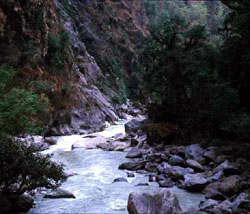 It is simple demand and supply: Nepal's electricity demand is increasing at 60 MW a year and no new major hydropower unit is coming onstream in the foreseeable future to cover the shortfall.
It is simple demand and supply: Nepal's electricity demand is increasing at 60 MW a year and no new major hydropower unit is coming onstream in the foreseeable future to cover the shortfall.
The coming winter and winters till 2013 will see power cuts lasting 8-10 hours a day even if new projects are undertaken right away. Still, at the Ministry of Water Resources and the Nepal Electricity Authority (NEA) it is difficult to detect a sense of urgency. The government is preoccupied with politics and the NEA has taken three months just to appoint a political crony with an irrigation background as chief and it still doesn't have a board of directors.
Besides political lethargy, the reason for the energy emergency is that Nepal's hydropower units generate surplus electricity during the wet season but have a deficit during the dry months. This means there will be a 150MW shortfall during peak hours in the dry season.
Experts say that the only alternative to power cuts in the short-term is a campaign to reduce demand. But in the medium and long term, Nepal needs to immediately begin work on new hydropower plants for domestic consumption and export.
Loss from the grid due to pilferage and technical reasons is 24 percent, one of the highest in the world. Reducing this by half would be equivalent to installing a new 60MW powerplant. A campaign to get consumers to switch from incandescent to compact fluorescent lamps could reduce nationwide energy demand by another 40MW.
Implementing seasonal tariffs for industries would earn NEA Rs 2 billion a year selling flood energy that would otherwise be wasted and time-of-day pricing would reduce peak demand by another 20MW. Even on the generation side, the situation needn't be so precarious. A dozen determined private Nepali investors are already
adding about 30MW a year with local financing.
Keeping policies stable and predictable despite changes in government, streamlining rules and reducing hassles for license-holders would encourage more Nepali investors to turn to hydropower.
"The government should make it easy for Nepali investors to make money off the power market," says former water resources minister Dipak Gyawali. "The laws should be made Nepali-friendly and if there are projects too big for domestic investors, outside partners should be asked to take part through competitive bidding."
Higher prices for peak power would encourage Nepali private investors to go for storage projects, Gyawali says, and the government could then concentrate on large dams to even out the seasonal energy gap.
The project that can come onstream earliest is the 309 MW Upper Tama Kosi that Norwegian power company Statkraft Nordfund Power Invest is interested in. An Indian and Chinese team have also expressed interest but the Norwegians are far ahead with preparations.
Statkraft has been talking to NEA about Upper Tama Kosi for over a year, but regime change in Kathmandu and slow decision-making within NEA have delayed action. The Norwegian company has also invested in a hydropower joint venture in India's Himachal Pradesh and wants to increase Upper Tama Kosi to 450 MW and export monsoon power to India.
Ratna Sansar Shrestha, a member of the board at Everest Bank, says Nepal needs a two-pronged approach in future to avoid power shortage: "NEA should offer seasonal and time-of-day tariffs to attract domestic investors to generate peak power and promote projects like Upper Tama Kosi through a competitive bidding process."
NEA officials say privately that they want to carefully evaluate the Norwegian proposal so there is no repetition of the Khimti debacle in the early 1990s when a government that wanted to show its investor-friendliness gave away too many concessions, including dollar denomination and an escalation clause on high tariffs.
"We are in a desperate situation again, and we don't want foreign investors to take advantage," said one NEA official cautiously.
The Norwegians are sweetening their offer with a promise to build the 28km access to road from Khimti to Lamobagar, and to bear up to 20 percent of the cost of the Rs 30 billion project. The rest of the investment would come from Statkraft, NEA and a local consortium led by Butwal Power Company (BPC).
If the final decision on Upper Tama Kosi is taken at the end of this year and construction starts in 2007 it will still take five more years to come on line. "We have to be fast," says Gyanendra Lal Pradhan of BPC. "If we start today we may be able to stop load shedding in seven years. If we don't, we'll have power cuts till 2016."
The real attraction of Upper Tama Kosi, however, is that it has a perfect match with India: it has a lot of spill energy during the monsoon just when demand on the north Indian grid is at a peak.
A 220 kVa transmission line from Khimti to Dhalkebar is nearly complete and when extended to the border will allow export of flood energy to India and import of electricity from the southern neighbour in winter when India has a surplus and Nepal has a shortage.
THE SHORTFALL
*70MW Middle Marsyangdi comes online Year Power Shortfall
(in megawatts)Powercut per day
in winter
(in hours) 2005 80 5 2006 120 8.5 2007 90* 5 2008 140 10 2009 200 12.5 2010 270 14


